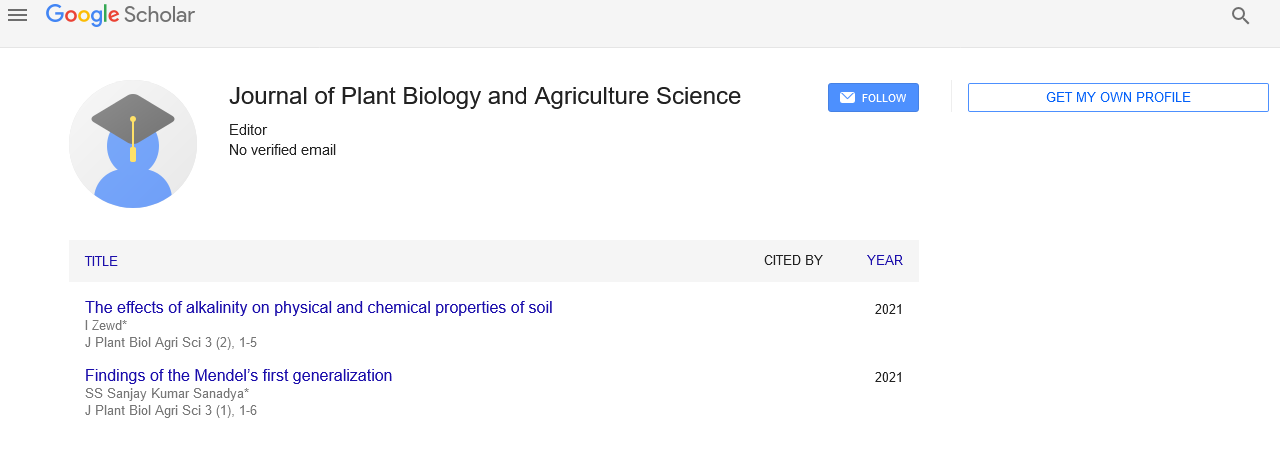Concerns about Stripe Rust
Received: 14-Apr-2022, Manuscript No. puljpbas-22-4864; Editor assigned: 16-Apr-2022, Pre QC No. puljpbas-22-4864(PQ); Accepted Date: Apr 26, 2022; Reviewed: 21-Apr-2022 QC No. puljpbas-22-4864(Q); Revised: 24-Apr-2022, Manuscript No. puljpbas-22-4864(R); Published: 28-Apr-2022, DOI: 10.37532/puljpbas.22.4(2).9-10
Citation: Marodan K. Concerns About Stripe Rust. J Plant Biol Agric Sci. 2022; 4(2):9-10.
This open-access article is distributed under the terms of the Creative Commons Attribution Non-Commercial License (CC BY-NC) (http://creativecommons.org/licenses/by-nc/4.0/), which permits reuse, distribution and reproduction of the article, provided that the original work is properly cited and the reuse is restricted to noncommercial purposes. For commercial reuse, contact reprints@pulsus.com
Abstract
In the 21st 100 years, the wheat stripe rust parasite has developed to be the biggest biotic limit to worldwide wheat creation. New microorganism genotypes are more forceful and ready to contaminate beforehand safe wheat assortments, prompting quick microbe relocation across and between landmasses. We currently realize the full life cycle, micro evolutionary connections and past movement courses on a worldwide scale. Current sequencing advances have given the primary parasitic draft genomes and improved on plant obstruction quality cloning. However, we don't know anything about the sub-atomic and micro evolutionary instruments that work with the disease interaction and cause new obliterating microbe races. These are the issues that should be tended to by taking advantage of the collaborations between clever 21st century science instruments and many years of devoted pathology work.
Introduction
Right now, 88% of the world's wheat creation is powerless to wheat stripe rust, prompting worldwide misfortunes of more than 5 milli- on tons of wheat with an expected market worth of $USD 1 billion every year. Wheat stripe rust is otherwise called wheat yellow rust as a result of its spore tone during its agamic contamination cycle on wheat. The sickness is brought about by the commit biotrophic organism. The danger of this growth to horticulture is established in its gigantic hereditary variety because of sexual recombination happening transcendently in the Himalayan area, its significant distance dispersal across mainlands by normal and human means, and its quick neighborhood variation through stepwise development, defeating a solitary obstruction quality at a time. Hereditary control of wheat stripe rust is accomplished by north of 50 officially named Yellow Rust (Yr) Resistance (R) qualities recognized by the consistent endeavors of plant reproducers and pathologists over the last 100 yr. By and large, pathologists have zeroed in on the separation of this from wheat fields and have decided the capacity of these confines to contaminate a characterized set of wheat lines conveying different Yr R qualities.
Discussion
The focal point of beginning for yellow rust is thought to be Transcaucasia where grasses were the essential host, and from that point the microbe presumably moved into Europe and along the mountain reaches to China and eastern Asia. It was guessed that stripe rust likely entered North America through the Aleutian Islands and Alaska and tainted wild grasses. Likewise, it might have come to North American with ancient individuals through water as opposed to a land span or may have been available before the division of the landmasses. Notwithstanding how the microbe showed up, an Asian beginning of the wheat and grass rust is generally conceivable
Stripe rust didn't come to eastern North America alongside presentation of oats from Europe. The sickness was broadly appropriated and common on local grass has in the West however missing in the East. Stripe rust of wheat, brought about by is one of the most broadly disastrous plant sicknesses on the planet and the main infection of wheat in western North America since the 1960s. It has become progressively significant in the south-focal United States since the mid 1980’s. Stripe rust was known to be a damaging infection in Western Europe and Russia what's more, a common illness in Egypt, Algeria, Japan, and India. The early plant pathologists in North America knew about the danger of stripe rust and dreaded its conceivable spread from the western states to the wheat-developing areas of the Great Plains, Mississippi Valley, and Atlantic Coast (94). That worry, joined with the requirement for growing wheat creation during World War I, given the improvement to quick research on the infection. Early examination (1915 to mid-1930s) was principally on the source and beginning of stripe rust; monetary significance and geographic dissemination of stripe rust, have reach and job of grasses as an inoculum source, and cultivar opposition; life history, scientific classification, morphology, furthermore, disease process; impact of field and controlled natural circumstances on infection improvement; and pathogenic structures and races.
Conclusion
Current sequencing advancements have sped up Yr R quality cloning from wheat and have established the groundwork for in-field microorganism ID. To expand on these establishments and to realize their true capacity, the local area needs to team up synergistically, while playing to individual qualities. We really want straightforwardly accessible haplotype-staged coterminous reference genomes and a steady change framework.
Such essential advances will empower us to test and address significant natural inquiries including the accompanying. What is the R quality perceived effectors? What are the molecular components driving development at nucleotide goal? What is the commitment of every haploid genome to the advancement of new pathogen destructiveness profiles? In synopsis, we might have the option to gain real headway on grasping the sub-atomic implies that makes this such a deadly microbe.
Keywords
wheat; stripe rust; pathogen; disease





